Design for Manufacturing (DFM): A Guide to Optimizing Product Development
The difference between success and failure often hinges on decisions made long before a product reaches the assembly line.
Enter Design for Manufacturing (DFM), a revolutionary approach that’s transforming how we conceptualize, develop, and produce goods across industries.
But what exactly is DFM, and why has it become the cornerstone of modern manufacturing excellence?
Design for Manufacturing, also known as Design for Manufacturability, is a comprehensive methodology that integrates manufacturing considerations into the product design process from the very beginning.
It’s not just about creating a great product; it’s about creating a great product that can be efficiently and cost-effectively manufactured at scale, often leveraging structured improvement methodologies learned through six sigma certification to achieve optimal results.
Key Highlights
- Know what is Design for Manufacturing
- Core principles
- Examples of DFM in action
- Guidelines for implementing
What is Design for Manufacturing (DFM)?
Design for Manufacturing (DFM), also known as Design for Manufacturability, is a comprehensive approach to product design that focuses on optimizing the manufacturing process from the earliest stages of development.
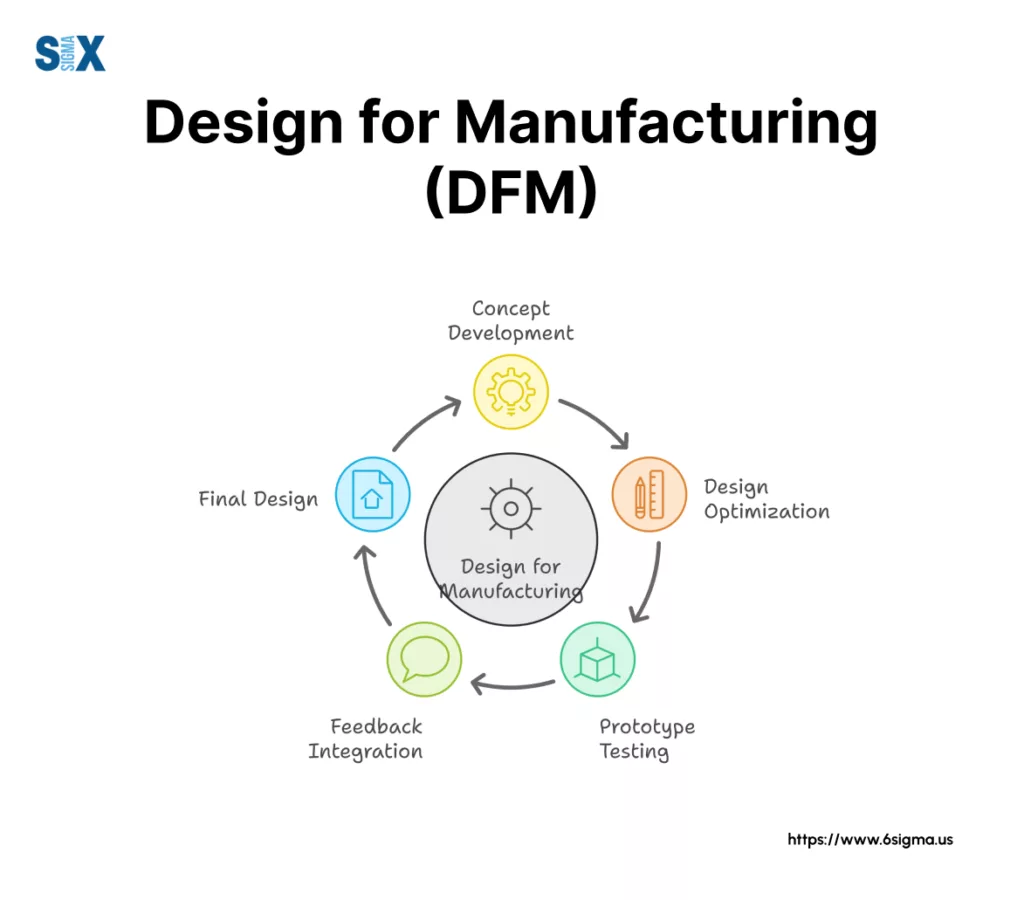
Definition and Core Concepts
In simple terms, Design for Manufacturing is the practice of designing products with manufacturing in mind.
It’s about anticipating and addressing potential production challenges before they arise, ensuring a smoother transition from design to manufacturing.
The core concepts of DFM include:
- Early consideration of manufacturing processes
- Simplification of product design
- Standardization of components
- Optimization of material usage
- Reduction of assembly steps
DFM is often confused with related concepts such as Design for Assembly (DFA) and Design for Manufacturing and Assembly (DFMA). While these approaches share similar goals, they have distinct focuses:
- DFM concentrates on optimizing the design for ease of manufacturing.
- DFA focuses specifically on simplifying the assembly process.
- DFMA combines both approaches, addressing both manufacturing and assembly concerns.
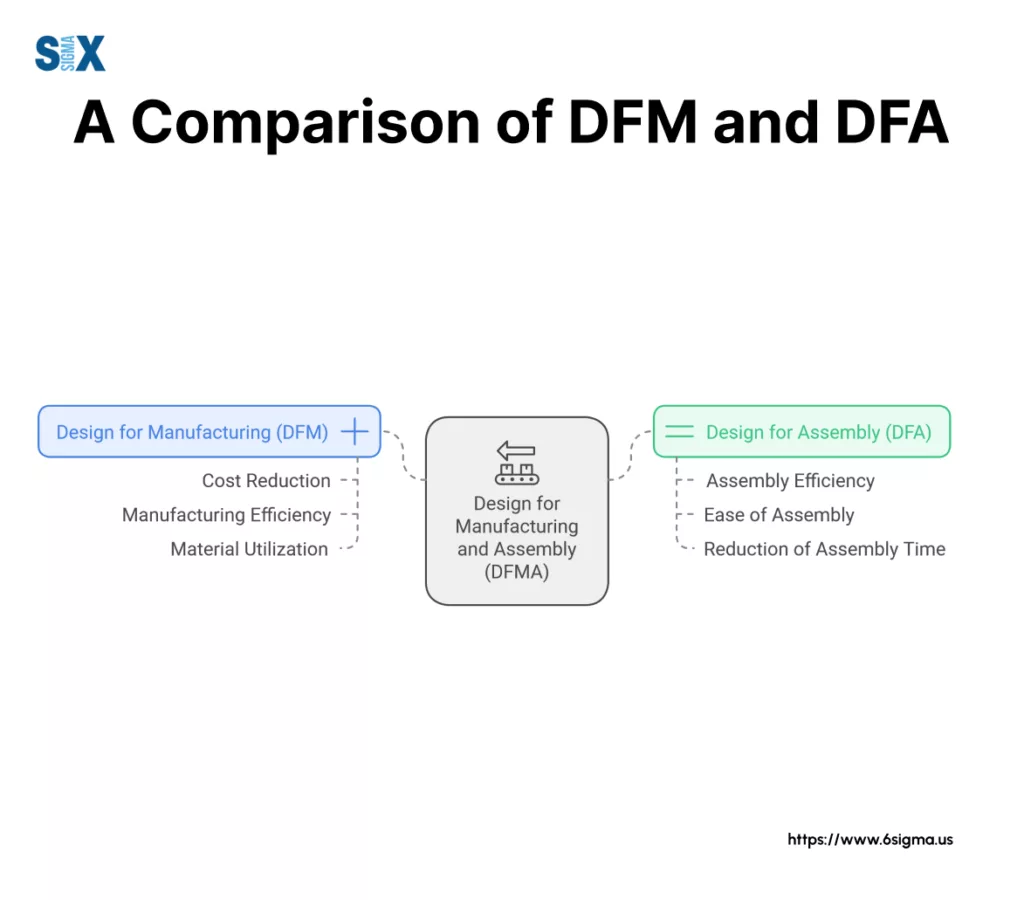
Understanding these methodologies is crucial, and professionals often find that pursuing a six sigma certification provides the robust analytical and problem-solving framework needed to effectively implement DFM principles across the product lifecycle.
By implementing DFM principles, companies can significantly reduce production costs, improve quality, and accelerate time-to-market. To further enhance these skills, professionals can pursue a six sigma certification, which equips them with tools to streamline processes and eliminate defects in manufacturing.
Revolutionize your product design process with our DFSS White Belt course provides essential tools to implement Design for Manufacturing principles.Transform your approach to product development and boost manufacturing efficiency today!
The Principles of Design for Manufacturing
Design for Manufacturing (DFM) is built upon a foundation of key principles that guide product designers and engineers towards creating products that are not only functional but also efficient to manufacture.
Principles like simplification and assembly optimization align closely with concepts taught in Lean Fundamentals, which emphasize streamlining processes and eliminating waste to maximize value.
Understanding and applying these principles is crucial for anyone looking to implement DFM effectively.
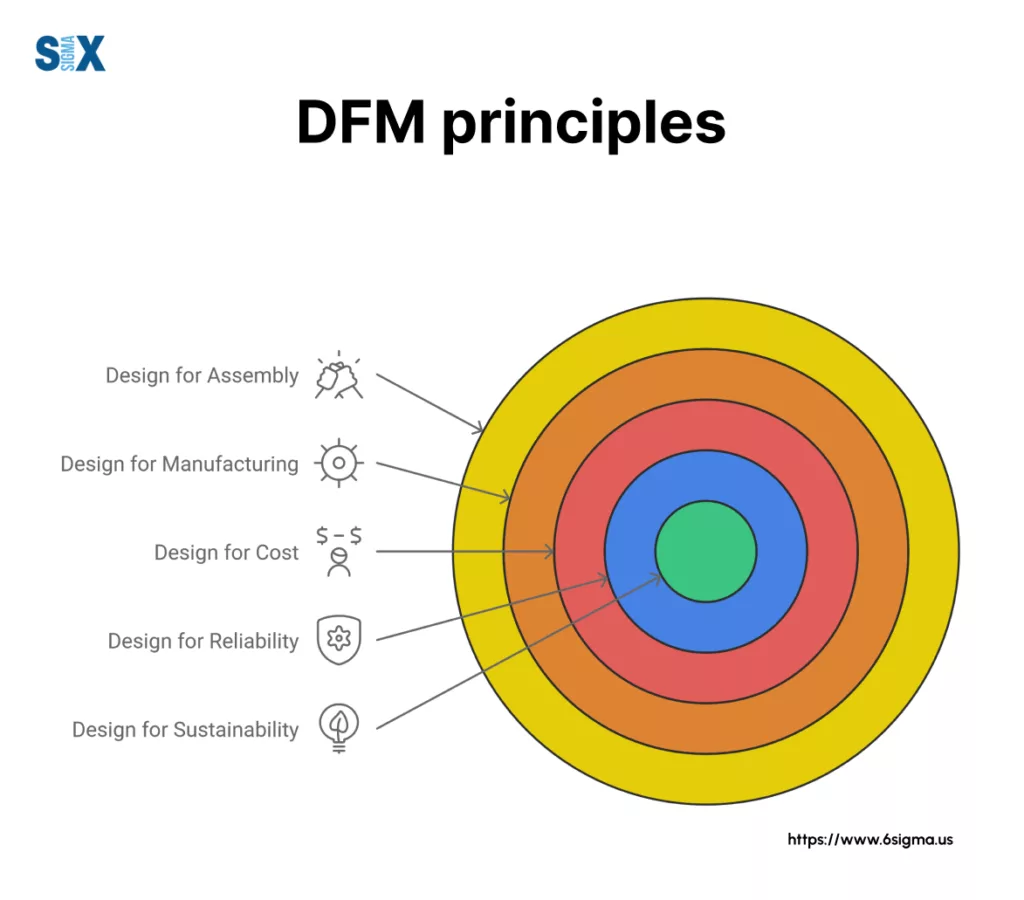
1. Simplification
The first principle of DFM is simplification. This involves reducing the complexity of a product’s design without compromising its functionality.
Simplification in design for manufacturability can lead to:
- Fewer components, reducing assembly time and costs
- Lower likelihood of errors during manufacturing
- Easier maintenance and repair
For example, in the automotive industry, simplifying the design of a car door handle by reducing the number of parts not only makes it easier to manufacture but also improves reliability.
2. Standardization
Standardization is a crucial aspect of design for manufacturing and assembly. This principle focuses on using standard components and processes wherever possible. Benefits include:
- Reduced inventory costs
- Easier sourcing of parts
- Simplified assembly processes
A real-world application of standardization can be seen in the electronics industry, where manufacturers often use standard USB ports across different devices, simplifying both production and user experience.
3. Material Selection
Choosing the right materials is a critical factor in the design for manufacture process. Proper material selection considers:
- Cost-effectiveness
- Ease of procurement
- Manufacturability
- Performance requirements
For instance, in the aerospace industry, the shift towards using composite materials in aircraft design exemplifies how material selection can dramatically impact both manufacturing processes and product performance.
4. Assembly Optimization
This principle focuses on designing products for easy and efficient assembly. Key considerations include:
- Minimizing the number of assembly steps
- Ensuring parts can only be assembled in the correct way
- Reducing the need for specialized tools
A classic example of assembly optimization is the design of IKEA furniture, where products are engineered for easy assembly by the end-user, significantly reducing manufacturing and shipping costs.
5. Quality Control Integration
Integrating quality control into the design process is the final principle of DFM. This involves:
- Designing features that facilitate easy inspection
- Incorporating error-proofing elements
- Ensuring consistent quality across production runs
In the medical device industry, for example, products often include built-in self-diagnostic features, showcasing how quality control can be integrated into the product design itself.
These principles of design for manufacturability are interconnected and often overlap. For instance, simplifying a design often leads to easier assembly and can facilitate better quality control.
Similarly, standardization can simplify material selection and assembly processes.
By applying these design for manufacturing principles and using this checklist, you can significantly improve your product’s manufacturability, reduce costs, and enhance overall quality.
Remember, DFM is an iterative process, and these principles should be revisited throughout the product development lifecycle to ensure optimal results.
Implementing Design for Manufacturing: A Step-by-Step Guide
Implementing Design for Manufacturing is a crucial process that can significantly improve product quality, reduce costs, and streamline manufacturing processes.
This step-by-step guide will walk you through the key stages of DFM implementation, providing practical insights and addressing common challenges along the way.
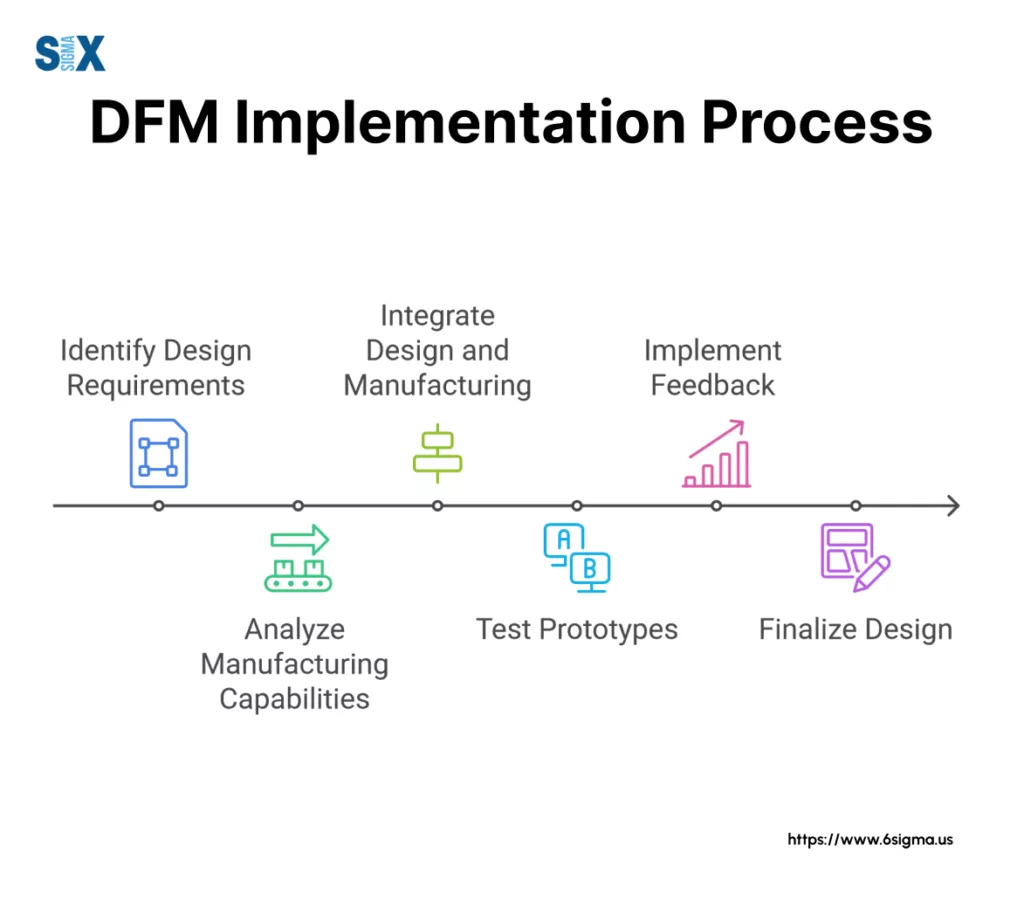
Early Integration in Product Development
The first step in implementing DFM is to integrate it early in the product development cycle.
This approach, often referred to as design for manufacturing, which ensures that manufacturability considerations are addressed from the outset.
Key actions:
- Involve manufacturing engineers in initial design discussions
- Conduct preliminary DFM assessments during concept development
- Establish DFM guidelines specific to your product and industry
Example: A smartphone manufacturer integrating DFM principles from the initial design phase resulted in a 30% reduction in assembly time for their latest model.
Cross-Functional Team Collaboration with Design for Manufacturing
Successful DFM implementation requires collaboration across various departments. This cross-functional approach is essential for design for manufacturing and assembly.
Steps to foster collaboration:
- Form a dedicated DFM team with representatives from design, engineering, manufacturing, and quality control
- Conduct regular DFM review meetings
- Implement a shared platform for design and manufacturing data
Challenge: Resistance to change from established departments
Solution: Provide DFM training and showcase early successes to build buy-in
Design for Manufacturing (DFM) Analysis Techniques
Employing robust DFM analysis techniques is crucial for identifying and addressing manufacturability issues early in the design process.
Key techniques:
- Design for Manufacturability (DFM) software analysis
- Failure Mode and Effects Analysis (FMEA)
- Design for Assembly (DFA) evaluation
Complementing these evaluations, root cause analysis training equips teams with systematic methods to pinpoint the fundamental reasons behind manufacturability issues identified during DFM reviews, preventing recurrence.
Tools and software for DFM analysis:
- SolidWorks DFM
- Siemens NX
- AutoDesk Fusion 360
These tools can significantly enhance your design for manufacturing process, providing insights that might be missed in manual reviews.
Iterative Design Process
DFM is not a one-time activity but an iterative process that continues throughout product development. This approach to design for manufacture ensures continuous improvement.
Steps in the iterative process:
- Initial design
- DFM analysis
- Design modifications
- Re-analysis and validation
- Repeat steps 2-4 until optimal design is achieved
Example: An automotive parts manufacturer reduced production costs by 25% through three iterations of DFM analysis and design refinement.
Validation and Testing
The final step in implementing DFM is thorough validation and testing. This stage ensures that the product meets all design for manufacturability criteria and performs as intended.
Key validation steps:
- Prototype production
- Manufacturing process simulation
- Quality control testing
- Pilot production run
Challenge: Balancing thorough testing with time-to-market pressures
Solution: Utilize rapid prototyping technologies and virtual testing environments to accelerate the validation process
Implementing DFM effectively requires a systematic approach and commitment from all stakeholders.
By following this step-by-step guide, you can navigate the complexities of the design for manufacturing process and reap the benefits of improved producibility, reduced costs, and enhanced product quality.
Remember, successful DFM implementation is an ongoing process. Continuously refine your approach, stay updated with the latest design for manufacture principles, and always seek opportunities to optimize your manufacturing processes.
Take your Design for Manufacturing skills to the next level. Our Green Belt certification equips you with advanced tools to optimize every aspect of your production process.
Design for Manufacturing (DFM) in the Context of Industry 4.0 and Smart Manufacturing
As we enter the era of Industry 4.0, Design for Manufacturing is evolving to embrace new technologies and methodologies.
This integration is revolutionizing the way we approach design for manufacturability, creating unprecedented opportunities for efficiency, quality, and innovation in manufacturing processes.
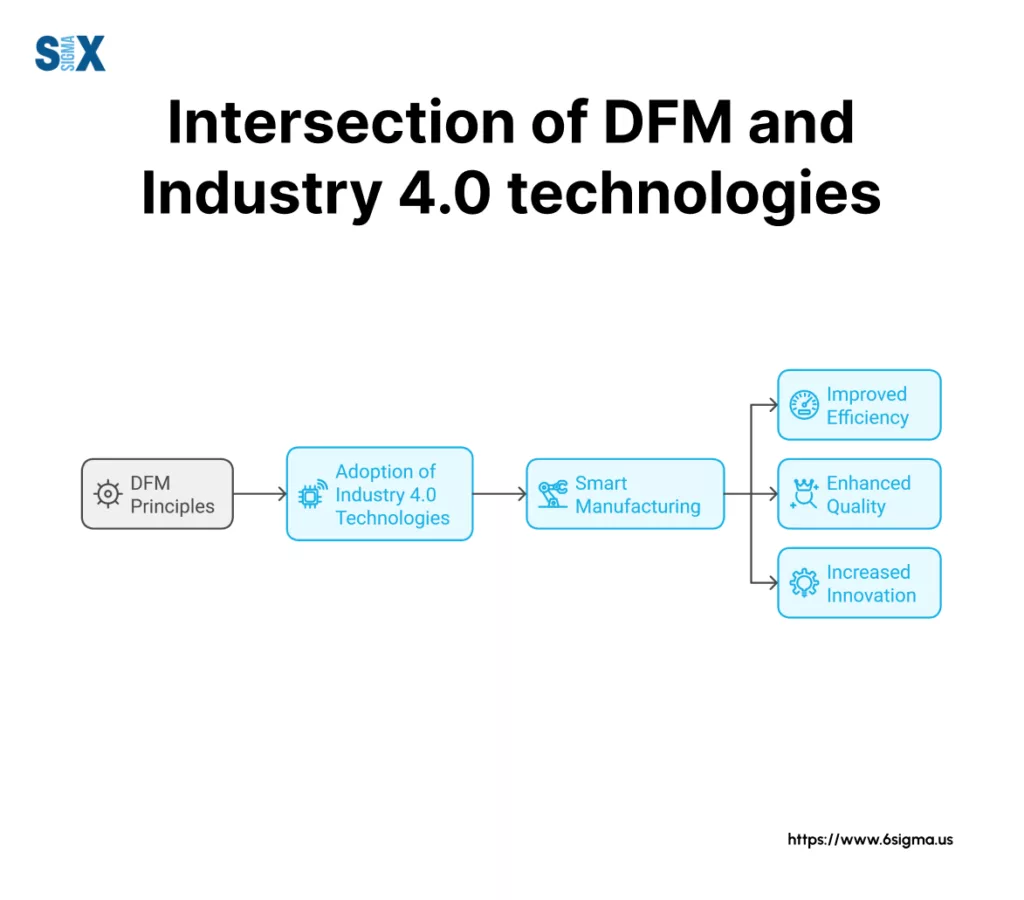
Integration with IoT and Data Analytics
The Internet of Things (IoT) and advanced data analytics are transforming design for manufacturing and assembly.
By incorporating smart sensors and real-time data collection into the manufacturing process, companies can:
- Monitor production in real-time
- Identify bottlenecks and inefficiencies quickly
- Make data-driven decisions to optimize design for manufacture processes
For example, a leading automotive manufacturer implemented IoT sensors throughout their production line, allowing them to collect data on every aspect of their design for manufacturing assembly process.
This led to a 15% increase in overall efficiency and a 20% reduction in defects.
AI and Machine Learning in Design for Manufacturing
Artificial Intelligence (AI) and Machine Learning (ML) are revolutionizing software design for manufacturing.
These technologies can:
- Analyze vast amounts of historical data to predict potential manufacturing issues
- Optimize design parameters for improved manufacturability
- Automate repetitive design tasks, freeing up engineers for more complex problem-solving
A case study in the electronics industry showcases how AI-powered dfm design for manufacturing software reduced design iterations by 40% and shortened time-to-market by two months.
Digital Twins and Simulation
Digital twin technology is a game-changer for design for manufacturability dfm.
By creating a virtual replica of the entire manufacturing process, engineers can:
- Simulate and optimize manufacturing processes before physical implementation
- Test different design for manufacture principles in a risk-free environment
- Identify potential issues early in the product development cycle
For instance, a medical device company used digital twin technology to simulate their manufacturing process, resulting in a 30% reduction in production costs and a 50% decrease in time-to-market for their new product line.
The intersection of DFM and Industry 4.0 presents both challenges and opportunities:
Challenges:
- Integrating new technologies with existing systems
- Ensuring data security and privacy
- Training workforce in new digital skills
Opportunities:
- Unprecedented levels of customization in manufacturing
- Rapid prototyping and iterative design
- Predictive maintenance to reduce downtime
As we look to the future, the design for manufacture process will continue to evolve.
Key trends to watch include:
- Increased use of augmented reality in design and assembly
- Integration of blockchain for secure, transparent supply chains
- Advanced materials science informing design for manufacturing guidelines
To fully leverage these advancements, companies must stay agile and continuously update their approach to design for manufacturing.
This might involve:
- Investing in ongoing training for design and manufacturing teams
- Collaborating with technology partners to stay at the cutting edge
- Fostering a culture of innovation and continuous improvement
By embracing these new technologies and methodologies, manufacturers can enhance their design for manufacturability, leading to more efficient processes, higher quality products, and a stronger competitive position in the global marketplace.
In conclusion, the integration of DFM with Industry 4.0 technologies is not just a trend, but a necessity for manufacturers aiming to stay competitive.
lead the future of manufacturing? Our Black Belt course provides comprehensive training in advanced process improvement and smart manufacturing techniques.
Sustainability and Design for Manufacturing (DFM): Designing for a Circular Economy
Integrating sustainability into design for manufacturing (DFM) practices has become paramount.
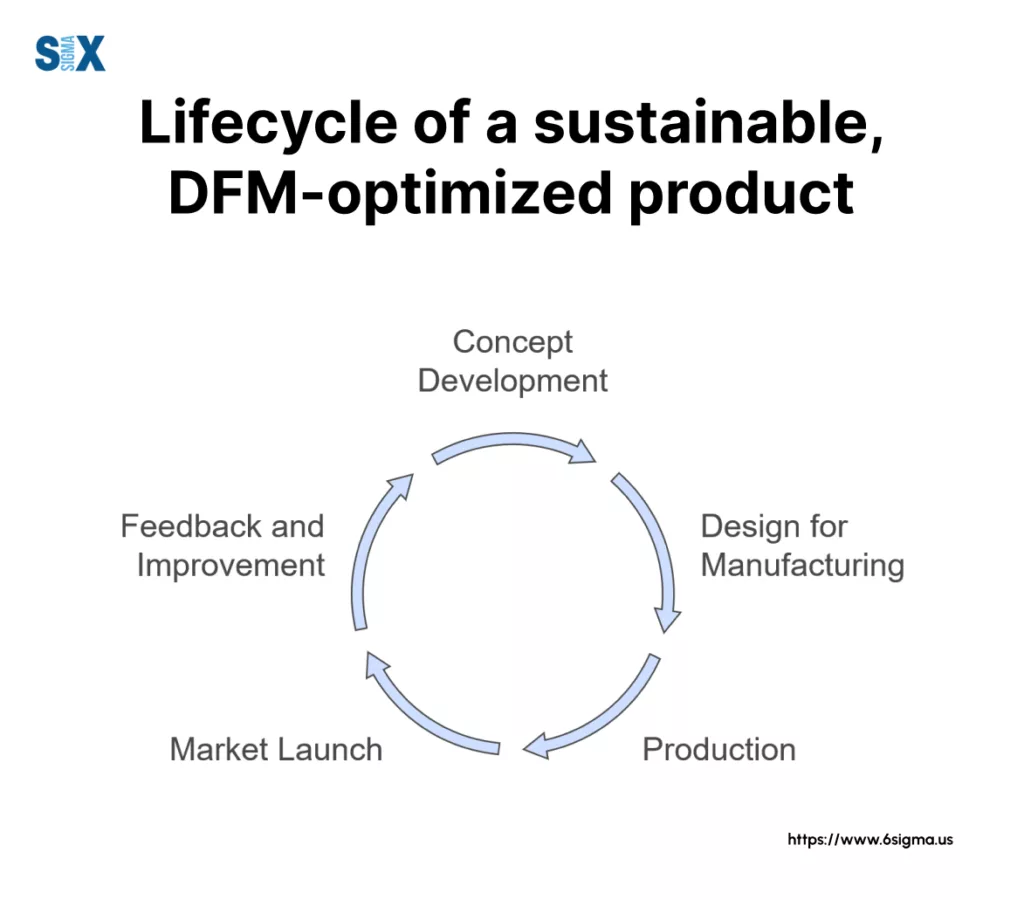
Eco-Friendly Material Selection
One of the fundamental aspects of sustainable design for manufacturing is the careful selection of materials.
Manufacturers are increasingly focusing on:
- Renewable resources: Using materials that can be replenished naturally
- Recycled content: Incorporating previously used materials into new products
- Biodegradable options: Choosing materials that decompose naturally at the end of their lifecycle
Case Study: A leading electronics manufacturer reduced their carbon footprint by 30% by switching to recycled plastics in their product casings, demonstrating how design for manufacturing principles can align with sustainability goals.
Design for Disassembly and Recycling
Incorporating disassembly and recycling considerations into the design for manufacturing process is crucial for a circular economy.
Key strategies include:
- Modular design: Creating products with easily separable components
- Standardized parts: Using common components across product lines for easier recycling
- Avoid mixed materials: Designing products with easily separable material types
Example: An automotive company redesigned their vehicle dashboard using design for manufacturability dfm principles, resulting in a 40% increase in recyclable components and a 25% reduction in assembly time.
Lifecycle Analysis in Design for Manufacturing (DFM)
Integrating lifecycle analysis into the design for manufacturing process helps identify environmental impacts throughout a product’s life.
This involves:
- Raw material extraction assessment
- Manufacturing process evaluation
- Use phase energy consumption analysis
- End-of-life disposal or recycling considerations
By incorporating lifecycle analysis, manufacturers can make informed decisions that balance manufacturability with sustainability.
Sustainable DFM practices align closely with circular economy goals by:
- Minimizing waste through efficient design – a principle central to Lean fundamentals, which emphasize resource optimization.
- Extending product lifespan through durability and repairability
- Facilitating material recovery at the end of product life
Case Study: A furniture manufacturer implemented lifecycle analysis in their design for manufacturing process, leading to a 50% reduction in material waste and a 20% increase in product lifespan.
To effectively implement sustainable DFM practices, consider the following steps:
- Establish sustainability goals alongside manufacturing objectives
- Train design and engineering teams in eco-design principles
- Collaborate with suppliers to source sustainable materials
- Invest in technologies that support both efficient manufacturing and sustainability
- Continuously measure and improve environmental performance
By embracing these sustainable design for manufacturability practices, companies can not only reduce their environmental impact but also gain a competitive edge in an increasingly eco-conscious market.
The integration of sustainability into DFM processes represents a crucial step towards a more circular and responsible manufacturing industry.
As we move forward, the intersection of sustainability and design for manufacturing will continue to evolve.
Measuring the Success of Design for Manufacturing (DFM)
Implementing Design for Manufacturing (DFM) is crucial, but equally important is measuring its success.
By establishing and tracking key performance indicators (KPIs), organizations can quantify the impact of their DFM initiatives and identify areas for continuous improvement.
Cost Reduction Metrics
One of the primary goals of design for manufacturing is to reduce costs. Key metrics include:
- Material cost savings
- Labor cost reduction
- Tooling and equipment cost optimization
- Overall product cost decrease
Example: A consumer electronics company tracked a 25% reduction in material costs after implementing DFM principles in their latest product line.
Time-to-Market Improvements
DFM can significantly accelerate product development cycles.
Measure:
- Design cycle time reduction
- Prototype development speed
- Manufacturing ramp-up time
- Overall time-to-market
Case Study: An automotive parts manufacturer decreased their time-to-market by 40% through rigorous application of design for manufacturing and assembly techniques.
Quality and Defect Reduction with Design for Manufacturing
Improved product quality is a key outcome of effective DFM. Track:
- Defect rates in production
- First-pass yield improvements
- Field failure rates
- Warranty claim reductions
Success Story: A medical device company reduced defect rates by 60% after implementing comprehensive DFM guidelines.
Customer Satisfaction and Market Performance
Ultimately, DFM should positively impact customer satisfaction and market performance.
Monitor:
- Customer satisfaction scores
- Product return rates
- Market share growth
- Revenue increase attributed to DFM improvements
Real-world Impact: A home appliance manufacturer saw a 15% increase in customer satisfaction scores following a DFM-driven product redesign.
To effectively set up KPIs for DFM:
- Align metrics with overall business objectives
- Establish a baseline before DFM implementation
- Set realistic, time-bound targets
- Involve cross-functional teams in KPI development
- Regularly review and adjust KPIs as needed
Tools for measuring DFM success include:
- Data analytics platforms
- Manufacturing execution systems (MES)
- Product lifecycle management (PLM) software
- Customer relationship management (CRM) systems
Continuous improvement in DFM processes is vital.
Consider:
- Regular DFM audits
- Feedback loops from production to design teams
- Ongoing training and skill development
- Benchmarking against industry best practices
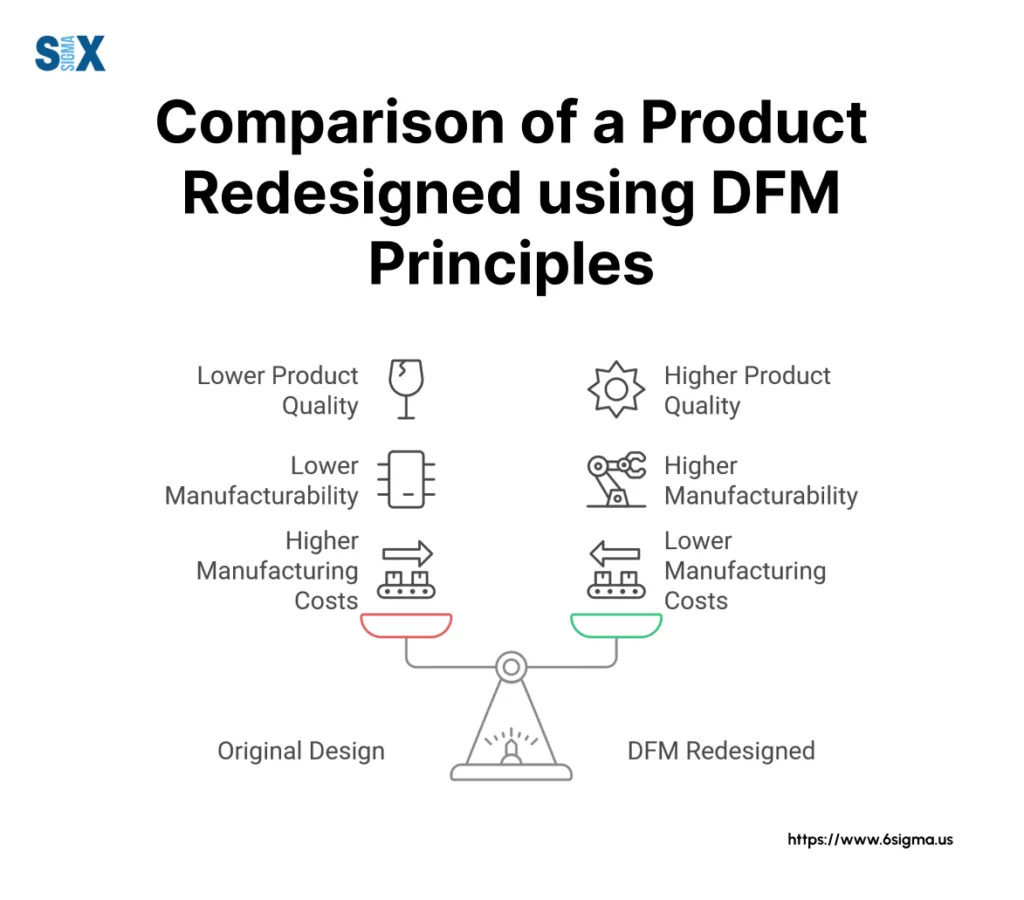
Conclusion
Design for Manufacturing (DFM) has emerged as a critical strategy in modern manufacturing, offering a pathway to enhanced efficiency, reduced costs, and improved product quality.
Throughout this article, we’ve explored the fundamental principles of DFM, its implementation process, and its impact across various industries.
Key takeaways include:
- DFM is not just a design technique, but a holistic approach to product development
- Early integration of DFM principles can lead to significant cost savings and quality improvements
- Cross-functional collaboration is crucial for successful DFM implementation
- Emerging technologies like AI and IoT are reshaping DFM practices
- Sustainability considerations are increasingly important in DFM strategies
Embracing DFM principles will be essential for organizations looking to stay competitive.
We encourage you to assess your current practices and consider how implementing or enhancing DFM strategies could benefit your organization.
Remember, the journey to DFM excellence is ongoing. Start small, measure your progress, and continuously refine your approach.
By doing so, you’ll be well-positioned to reap the rewards of more efficient, cost-effective, and high-quality manufacturing processes.
SixSigma.us offers both Live Virtual classes as well as Online Self-Paced training. Most option includes access to the same great Master Black Belt instructors that teach our World Class in-person sessions. Sign-up today!
Virtual Classroom Training Programs Self-Paced Online Training Programs






